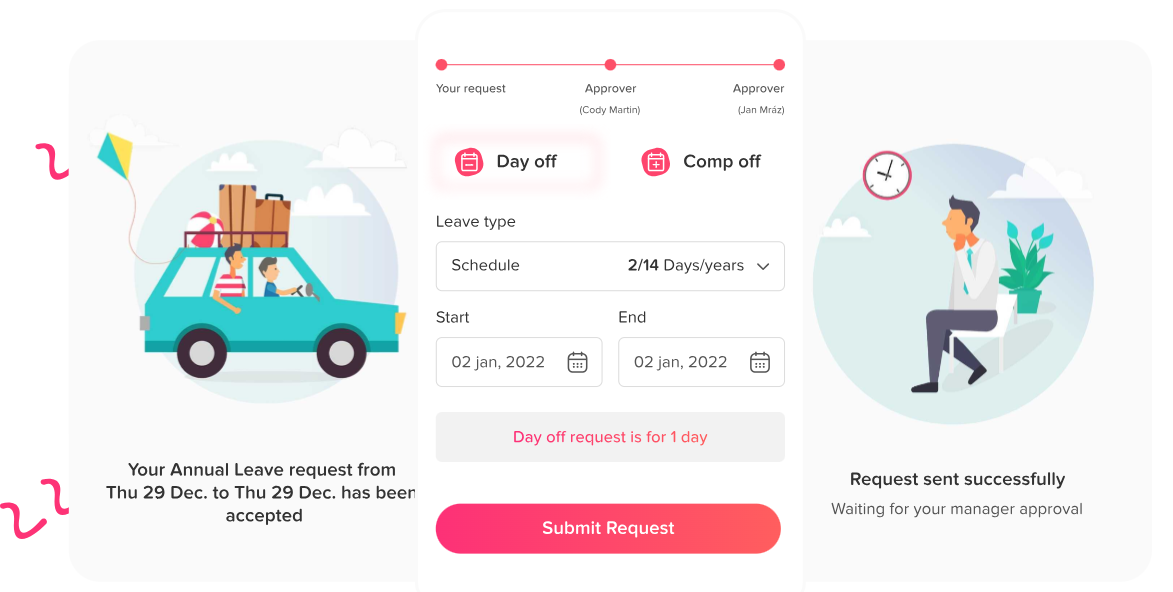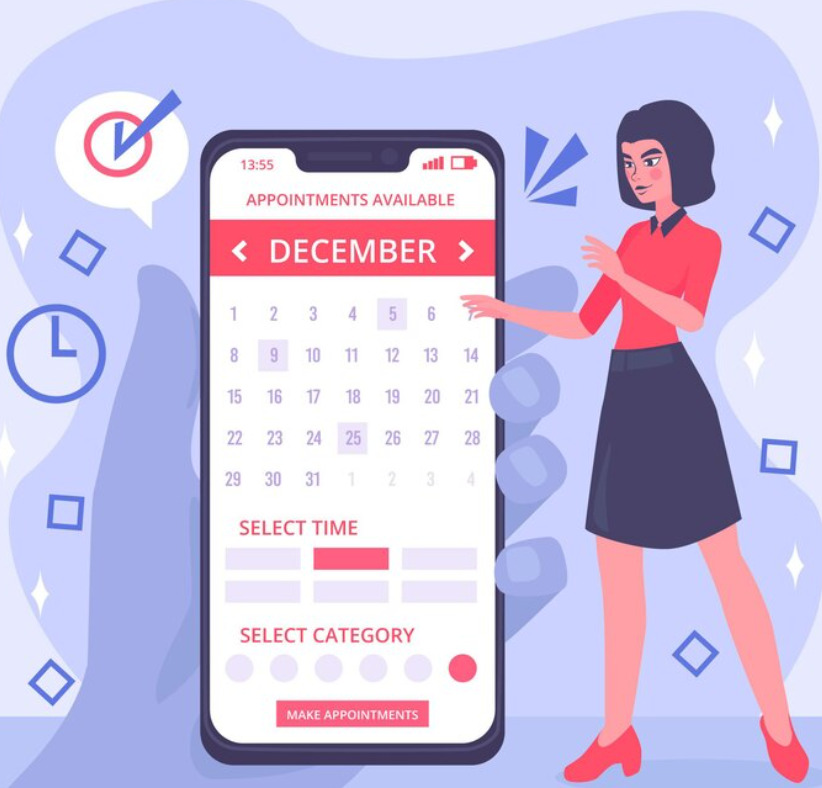Canada maternity leave policies are designed to support parents in balancing the joy and responsibility of welcoming a new child while managing their careers. The system reflects a commitment to family well-being and gender equality, offering both mothers and fathers (or adoptive parents) the opportunity to take time off work to care for their newborn or newly adopted children. This article provides an overview of Canada’s maternity and parental leave benefits, eligibility criteria, and how to apply for these benefits.
Day Off App is the #1 tracker for your team’s PTO, vacations and absences, Day Off will help you track maternity leave to respect the recipient’s work-life balance. In seconds you will set up your leave policies, approval workflow and enjoy a unique experience, integrate with Google Calendar, Outlook Calendar, Microsoft Teams, and Slack.
Overview of Maternity and Parental Leave in Canada
Canada distinguishes between maternity leave and parental leave. Maternity leave is specifically for birthing mothers and covers up to 15 weeks, allowing them time to recover from childbirth. Parental leave, on the other hand, is available to both parents and can be shared. It is designed for the care of the newborn or adopted child and can be taken any time within the first year (52 weeks) of the child’s arrival. Parents can choose between two options: the standard parental leave, which lasts up to 40 weeks (with a maximum of 35 weeks paid to one parent), and the extended parental leave, which extends up to 69 weeks (with a maximum of 61 weeks paid to one parent), but with a lower weekly benefit.
Eligibility Criteria
To be eligible for maternity or parental leave benefits in Canada, individuals must have worked for their employer for a minimum of 600 hours in the 52 weeks prior to the claim. They must also have a significant drop in their regular weekly earnings by more than 40% for at least one week, and be actively insured under the Employment Insurance (EI) program.
Application Process
Applicants for maternity or parental leave benefits must submit their claim to Service Canada. The application can be made online or in person at a Service Canada office. Required documentation typically includes a Social Insurance Number (SIN), proof of pregnancy or birth, and records of employment and earnings. It’s advisable to apply as soon as possible after the baby is born or the child is adopted, or as soon as the mother stops working.
Benefits
The amount of maternity and parental benefits is based on a percentage of the applicant’s average insurable weekly earnings, up to a maximum amount. As of the last update, the basic rate for calculating EI benefits is 55% of the average weekly earnings, up to a yearly maximum insurable amount. For extended parental leave, the rate is reduced to 33% of the average weekly earnings. It’s important to note that these benefits are taxable income, meaning federal and provincial or territorial taxes will be deducted.
Provincial and Territorial Variations
While the maternity and parental leave benefits outlined above are federally regulated, it’s important to note that each province and territory in Canada may offer additional benefits or have specific rules. For instance, Quebec administers its own Quebec Parental Insurance Plan (QPIP), which has different rates and eligibility requirements.
Canada Maternity Leave Policies, Frequently Asked Questions (FAQ)
What is the difference between maternity leave and parental leave in Canada?
Maternity leave in Canada is specifically designated for birthing mothers and provides up to 15 weeks of leave to allow for recovery after childbirth. Parental leave, on the other hand, is available to both parents, biological or adoptive, and can be shared between them. Parents can choose between the standard option (up to 40 weeks) or the extended option (up to 69 weeks), depending on their family’s needs. While maternity leave focuses on post-birth recovery, parental leave emphasizes bonding and child care.
Who is eligible for maternity and parental leave benefits in Canada?
To qualify for maternity or parental benefits under the Employment Insurance (EI) program, an individual must have worked at least 600 insurable hours in the 52 weeks before applying. Additionally, they must experience a minimum 40% reduction in weekly earnings and be actively insured under the EI program. Some employers may also offer supplemental benefits, known as “top-ups,” to bridge the gap between EI payments and full salary.
How much money can I receive during maternity or parental leave?
The EI maternity and parental benefits provide a percentage of your average insurable weekly earnings.
-
For standard benefits, you can receive 55% of your average weekly earnings, up to a maximum set annually by Service Canada.
-
For extended parental benefits, the rate is 33% of your average weekly earnings, but for a longer period.
It’s important to note that these benefits are considered taxable income, and federal and provincial taxes will be deducted.
How do I apply for maternity or parental leave benefits in Canada?
Applications for maternity or parental leave benefits are processed through Service Canada. You can apply online or in person at a Service Canada office.
You’ll need to provide:
-
Your Social Insurance Number (SIN)
-
Proof of pregnancy or birth (or adoption papers)
-
Records of Employment (ROE) from your employer
It’s best to apply as soon as you stop working or immediately after your child is born or adopted to avoid delays in receiving benefits.
Can both parents take parental leave at the same time?
Yes, both parents can take parental leave simultaneously or consecutively, depending on what works best for their family. The total parental leave duration can be shared between parents but cannot exceed the maximum entitlement (either 40 weeks for standard or 69 weeks for extended leave). This flexibility helps families divide caregiving responsibilities in a way that suits their household needs.
Are maternity and parental leave benefits available to adoptive parents?
Yes, adoptive parents are eligible for parental leave benefits under the same conditions as biological parents. However, maternity leave benefits are specifically reserved for birthing mothers, as they are meant to cover recovery after childbirth. Adoptive parents can still access up to 40 or 69 weeks of parental leave, depending on their chosen option.
How does maternity leave work for self-employed individuals in Canada?
Self-employed individuals can access maternity and parental benefits if they have registered for the Employment Insurance (EI) special benefits for self-employed people program. To qualify, they must have been enrolled for at least 12 months and have earned the minimum required self-employment income in the previous year. These benefits provide similar financial support as those available to employees.
Are there differences in maternity leave policies across provinces?
Yes. While the federal EI maternity and parental benefits program applies across Canada, some provinces and territories offer additional benefits or unique policies. For example, Quebec operates the Quebec Parental Insurance Plan (QPIP), which provides more generous payments and flexible eligibility requirements. Always check your province’s specific regulations to understand your exact entitlements.
Can an employer deny maternity or parental leave?
No, employers in Canada cannot legally deny an employee’s request for maternity or parental leave if they meet the eligibility requirements. Employment standards laws across provinces and territories protect parents from discrimination or job loss due to taking approved leave. Once the leave period ends, employees are entitled to return to their same or a comparable position.
How can employers manage maternity leave effectively?
Employers can streamline leave management using tools like the Day Off PTO Tracker, which helps track maternity and parental leaves, manage approval workflows, and ensure fair scheduling. It integrates with tools like Google Calendar, Outlook, Microsoft Teams, and Slack, ensuring business continuity while respecting employees’ work-life balance.
What happens if a parent wants to return to work early?
Parents can return to work before the end of their approved leave; however, they must inform their employer in advance, typically two to four weeks’ notice, depending on provincial laws. Early return may affect the total EI benefits received, so it’s recommended to check with Service Canada before making a final decision.
Are maternity and parental benefits taxable?
Yes, EI maternity and parental benefits are considered taxable income. Both federal and provincial or territorial taxes are automatically deducted from your payments. Depending on your income bracket, you might owe additional taxes or receive a refund when filing your annual tax return.
How soon should I apply for maternity leave benefits?
You should apply as soon as you stop working or after your baby’s birth (or adoption placement). If you delay your application by more than four weeks after your last day of work, you may lose some benefits, as payments are only retroactive for a limited period.
Can I receive other benefits while on maternity leave?
Yes, some employers offer supplemental top-up benefits that increase your total income while receiving EI payments. Additionally, depending on your situation, you may qualify for other federal or provincial support programs such as childcare benefits or tax credits for families.
How does the Day Off App help manage maternity leave?
The Day Off App simplifies leave tracking for HR teams and managers. It allows organizations to create customized maternity leave policies, automate approval workflows, and sync leave schedules with tools like Google Calendar and Slack. This helps maintain business efficiency while ensuring new parents receive the time and respect they deserve.
Conclusion
Canada’s maternity and parental leave policies are designed to provide significant support to new parents, allowing them to take necessary time off work to care for their children without undue financial hardship. By understanding the eligibility criteria, application process, and benefits available, parents can better plan for this important life event. Always check the most current policies and guidelines, as these can change and may vary by province or territory.











